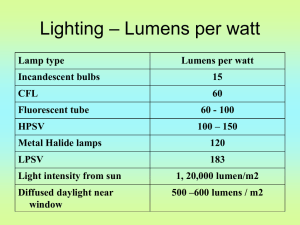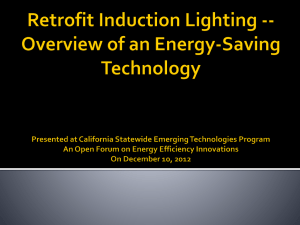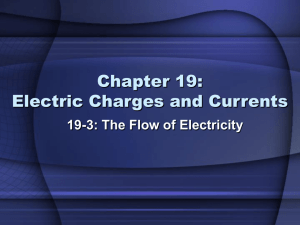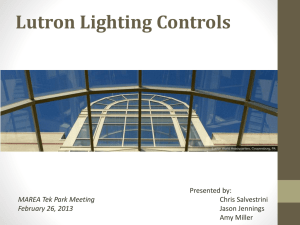Illuminating the night - Georgetown University Law Center
advertisement
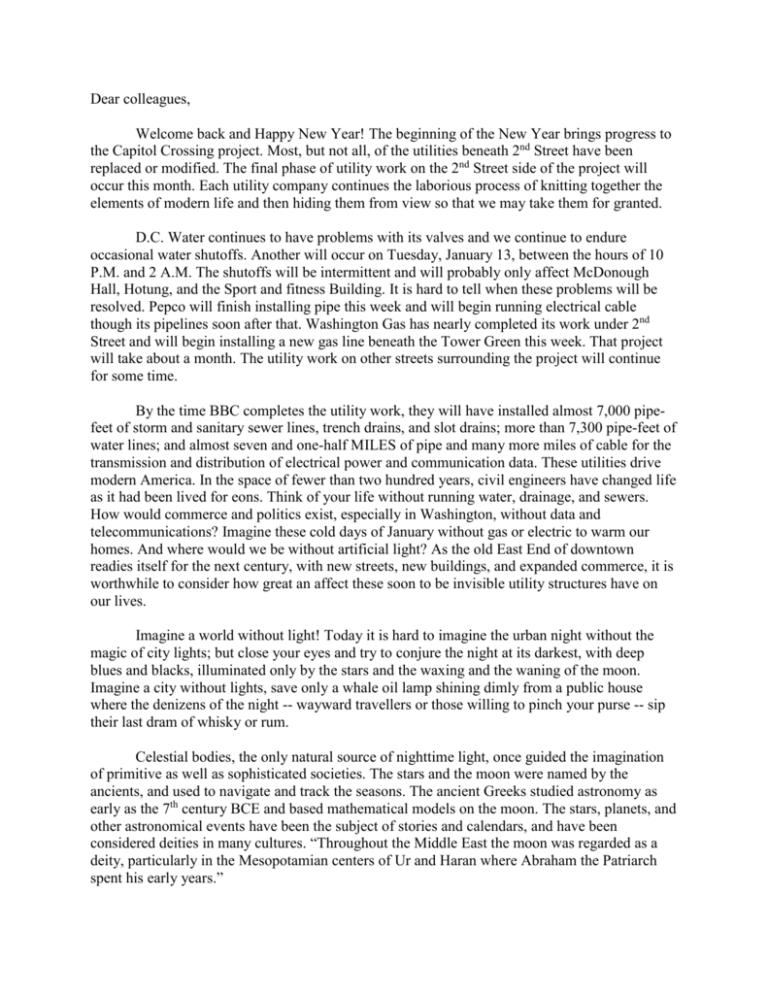
Dear colleagues, Welcome back and Happy New Year! The beginning of the New Year brings progress to the Capitol Crossing project. Most, but not all, of the utilities beneath 2nd Street have been replaced or modified. The final phase of utility work on the 2nd Street side of the project will occur this month. Each utility company continues the laborious process of knitting together the elements of modern life and then hiding them from view so that we may take them for granted. D.C. Water continues to have problems with its valves and we continue to endure occasional water shutoffs. Another will occur on Tuesday, January 13, between the hours of 10 P.M. and 2 A.M. The shutoffs will be intermittent and will probably only affect McDonough Hall, Hotung, and the Sport and fitness Building. It is hard to tell when these problems will be resolved. Pepco will finish installing pipe this week and will begin running electrical cable though its pipelines soon after that. Washington Gas has nearly completed its work under 2nd Street and will begin installing a new gas line beneath the Tower Green this week. That project will take about a month. The utility work on other streets surrounding the project will continue for some time. By the time BBC completes the utility work, they will have installed almost 7,000 pipefeet of storm and sanitary sewer lines, trench drains, and slot drains; more than 7,300 pipe-feet of water lines; and almost seven and one-half MILES of pipe and many more miles of cable for the transmission and distribution of electrical power and communication data. These utilities drive modern America. In the space of fewer than two hundred years, civil engineers have changed life as it had been lived for eons. Think of your life without running water, drainage, and sewers. How would commerce and politics exist, especially in Washington, without data and telecommunications? Imagine these cold days of January without gas or electric to warm our homes. And where would we be without artificial light? As the old East End of downtown readies itself for the next century, with new streets, new buildings, and expanded commerce, it is worthwhile to consider how great an affect these soon to be invisible utility structures have on our lives. Imagine a world without light! Today it is hard to imagine the urban night without the magic of city lights; but close your eyes and try to conjure the night at its darkest, with deep blues and blacks, illuminated only by the stars and the waxing and the waning of the moon. Imagine a city without lights, save only a whale oil lamp shining dimly from a public house where the denizens of the night -- wayward travellers or those willing to pinch your purse -- sip their last dram of whisky or rum. Celestial bodies, the only natural source of nighttime light, once guided the imagination of primitive as well as sophisticated societies. The stars and the moon were named by the ancients, and used to navigate and track the seasons. The ancient Greeks studied astronomy as early as the 7th century BCE and based mathematical models on the moon. The stars, planets, and other astronomical events have been the subject of stories and calendars, and have been considered deities in many cultures. “Throughout the Middle East the moon was regarded as a deity, particularly in the Mesopotamian centers of Ur and Haran where Abraham the Patriarch spent his early years.” But for the last half-century, the source of this wonder has all but disappeared. Today, although space exploration is common and satellites fill the skies, the Milky Way is invisible to the eyes of two-thirds of Americans and nearly 90 percent of humanity! To explore how a world of cities might appear if urban lights disappeared, view the collection of photos by Thierry Cohen at http://www.danzigergallery.com/artists/thierry-cohen or https://www.artsy.net/artist/thierry-cohen#! You might also explore the International Dark Sky Parks that are being created to remind people what the night really looks like. http://www.treehugger.com/natural-sciences/new-international-dark-sky-park-opens-inmichigan-only-nine-others-in-the-world.html or http://www.treehugger.com/naturalsciences/stars-over-grand-canyon-youve-never-seen-them-video.html if you have never seen the Grand Canyon or Death Valley at night. Although the darkness of night once engendered wonder, it also brought fear and danger to medieval cities that their leaders sought to dispel. “In 1417, Sir Henry Barton, Mayor of London, ordained ‘lanterns with lights to be hanged out on the winter evenings between Hallowtide and Candlemasse.’ In 1668, when some regulations were made for improving the streets of London, the residents were reminded to hang out their lanterns at the usual time, and, in 1690, an order was issued to hang out a light, or lamp, every night as soon as it was dark, from Michaelmas to Christmas. By an Act of the Common Council in 1716, all housekeepers, whose houses faced any street, lane, or passage, were required to hang out, every dark night, one or more lights, to burn from six to eleven o'clock, under the penalty of one shilling as a fine for failing to do so.” Link-boys were often employed to carry pine torches or lanterns for travelers to illuminate the dark, lonely, and dangerous passage ways of medieval cities. Paris is called the City of Light, harkening back to the day when candle, oil, and gas lights began to banish the night from the city. Paris was first lit by an order issued in 1524, and, in the beginning of the 16th century, the inhabitants were ordered to keep lights burning in the windows of all houses that faced the streets. Paris owes its system of street lighting to Gabriel Nicolas de la Reynie, the first Lieutenant General of the Paris police serving from 1667 to 1697. The expression "Paris, the City of Light” originated from Reynies’s efforts to make the Paris streets safer, although its full measure was achieved during the reconstruction of Paris by Baron George Eugene Haussmann between 1853 and 1870. We modern urbanites cannot fathom a city without lights, especially a city like Washington – a city of illuminated monuments and thriving public streets and spaces. But the pulsating, ubiquitous energy-powered light is relatively new to the world. Life before the invention of artificial lighting had a very different rhythm from our lives today. Clark Strand wrote an interesting essay in the New York Times recently about celebrating the Winter Solstice and I quote liberally from his article. Beginning in the late 19th century, the availability of cheap, effective lighting extended the range of waking human consciousness, effectively adding more hours onto the day — for work, for entertainment, for discovery, for consumption; for every activity except sleep, that nightly act of renunciation. Darkness was the only power that has ever put the human agenda on hold. In centuries past, the hours of darkness were a time when no productive work could be done. Which is to say, at night the human impulse to remake the world in our own image — so that it served us, so that we could almost believe the world and its resources existed for us alone — was suspended. The night was the natural corrective to that most persistent of all illusions: that human progress is the reason for the world. Advances in science, industry, medicine and nearly every other area of human enterprise resulted from the influx of light. The only casualty was darkness, a thing of seemingly little value. But that was only because we had forgotten what darkness was for. In times past people took to their beds at nightfall, but not merely to sleep. They touched one another, told stories and, with so much night to work with, woke in the middle of it to a darkness so luxurious it teased visions from the mind and divine visitations that helped to guide their course through life. Now that deeper darkness has turned against us. The hour of the wolf we call it — that predatory insomnia that makes billions for big pharma. It was once the hour of God. The District of Columbia began to light its streets in 1803 when an ordinance required the mayor to place lamps on most public streets, supply them with oil, and employ people to light and care for the lamps. The District’s first lighted street was Pennsylvania Avenue, which was lit briefly by oil lamps. The cost of keeping those lamps lit proved too high to be sustained while the city was struggling to rebuild after the British burned the Capitol in 1814. The lamps therefore went unlit for a year in 1818, during which the lampposts were used to tether horses. They were re-lit in 1819 and used for the next decade, except on moonlit nights. General use of public lighting was discontinued again in 1830. A few dozen whale oil lamps adorned the newly paved Pennsylvania Avenue but they too were soon extinguished because the declining whale population made the cost of fuel too high. No District of Columbia street was illuminated again until 1842. Once the whale oil lamps were extinguished, the night regained its mastery of the city. William Murdock was the first person to exploit gas for commercial lighting. He used gas extracted from coal first in his own house in Redruth, Cornwall in 1792, and then gave the first public demonstration of its utility in 1802. By 1807, Pall Mall in London was illuminated by gas lamps. Streets in Paris and Baltimore (the first American city to be so lighted) were illuminated by 1820, but the first gas lights in Washington were not installed until 1846. In that year, lamps burning Crutchett’s Solar Gas, manufactured from oil instead of coal, were installed on Capitol Hill and North Capitol Street. Crutchett was also authorized to mount a sixteen-foot lantern on a seventy-five foot pole at the top of the Capitol Dome, and later to put gas lamps in several federal office offices. Crutchett’s Solar Gas, however, could not be produced in high volume at a profit, so as gas lamps came into wider use, the city used flat-flame lamps and then incandescent mantle lamps which used a cheaper fuel. Crutchett’s patents were purchased by Benjamin B. French who organized the Washington Gaslight Company in 1848. That company continues to be the main supplier of gas in the Washington area today, although street lighting provides a very small part of its revenue. flat-flame lamps mantle lamps The oil and gas lamps were lit by lamp-lighters, successors to the link-boys mentioned earlier. The lamplighter became a familiar and romantic figure, wandering into neighborhoods at dusk to light the lamp and returning at dawn to extinguish it. During long winter nights, he often came twice, once to light the lamp and again to refill the oil tanks. Lamps were lit by means of a wick attached to a long pole and extinguished with a hook attached to the same pole. Newspapers mythologized lamp-lighters, using them as a metaphor for bringing light to sorrowful lives and for protecting the populace in times of danger. Early attempts to install gas lamps throughout the city often failed because they were considered dangerous and likely to injure lamplighters and strolling citizens. Efforts were also hampered by candle-makers and oil-dealers who lobbied hard to prevent their use. Nonetheless, by 1853, all of the District’s principal thoroughfares were illuminated by gas lamps. An 1853 city ordinance also directed the mayor to erect gas lamp posts on private property when requested by property owners. The cost of the lamps and the gas were borne by the owners. By 1875, gas lamps had completely replaced whale oil lamps. At that time, 3,561 gas lamps were in use in the city, and each burned 2,200 hours a year. Boss Shepherd, mentioned prominently in an earlier Construction Note about swamps and sewers, lit the city as well as drained it. Shepherd illuminated the city with thousands of gas lamps -- including 58 alone around the U.S. Capitol. Of course Shepherd never missed an opportunity to capitalize on the city’s seemingly endless flow of money. Most of those lamps he ordered were supplied by Shepherd’s own gas fitting company. By 1925, 12,000 gas lamps lit the streets of Washington, but by 1932, only 1,900 remained. Electricity began to do to the gas industry what gas had done to the whale oil and candle industry. Today, the only gas lamps we see in Washington stand in the front yards of privately owned residences in Georgetown and Capitol Hill. With the coming of electricity, the old lamplighter receded into memory, reverie, poetry, and song. Despite its advance, the public was at first wary of electric light technology. In an article called The Wonders of Electricity appearing in the February 1, 1897 issue of THE NATIONAL BUILDER, the author wrote “The facts regarding the adaptation of ‘electric currents’ are studiously covered by the initiated under a cloud of jargon unintelligible to an outsider, the creation of a congress of enthusiastic cranks and wiseacres, for their own peculiar benefit. … The cloud of mystery and bombast which the ‘science’ of electricity has engendered are typical of our inflated age, and it is high time some people of sense turned on it and made its limits apparent.” When the people of Woodstock, New York “got their first dose of electrical lighting in late 1924, they were appalled. ‘Old people swore that reading or living by so fierce a light was impossible,’ wrote the local historian Alf Evers.” Of course, early experiments with electricity did have its limits. There was always the risk of fire from the overhead transmission lines, and the direct current system devised by Thomas Edison was not very efficient. For example, power plants producing the 100 volts of electricity necessary to light a lamp had to be within one mile of it because the voltage declined as the distance between the source and the lamp increased. Edison’s competitor, Nicolas Tesla, solved the distance and other technological problems of transmission when he developed alternating current. When he did, electric lights began to gain supremacy over gas. The District of Columbia made its first attempt at outdoor electric lighting in 1881 using a carbon arc light to illuminate the statute of Civil War General George Henry Thomas at Thomas Circle. The carbon arc light, which produces an arc of light that flows in the air between carbon electrodes, was invented by Humphrey Davy in the early 1800s. It was the first practical electric light for street lighting until it was superseded by the incandescent light developed by Thomas Edison. The arc lamp used to illuminate General Thomas’ statute failed, however, because of faulty wiring between the lamp and its power plant at a nearby saw mill. President Garfield’s 1881 inaugural at the new National Museum occurred on the eve of the transition between the two forms of light. Newspapers said the building resembled “a crystal palace, its rotunda and dome sparkling with the whiteness of electric lights while the rest of the building glowed with yellowness of thousands of gas burners.” Also in 1881, the Heisler Electric Light Company established a small plant in the Washington Post Building and began powering a few lights near Pennsylvania Avenue and 10th Street. The United States Electric Lighting Company took over Heisler in 1882 and within one year powered 90 arc and 100 incandescent lamps. During the waning years of the 19th century, the United States Electric Light Company expanded its infrastructure in anticipation of a widening market. The fire risk associated with overheard wiring like that used in the Thomas Circle experiment was undeniable, so in 1884 the company constructed an underground conduit that would serve Pennsylvania Avenue. For the next three years, electric lights on Pennsylvania Avenue were powered at the company’s expense. In 1884 the District contracted with Brush Swan Electric Company for public lighting on Pennsylvania Avenue from the Capitol to the Treasury and for 5,000 yards on all streets radiating from the Capitol. The project included an experiment that briefly replaced 278 gas lamps that lit the Capitol with electric lighting and reflectors, but that effort was abandoned (and the gas lights re-lit) because the new lights alternately blinded drivers, or failed to cut through thick foliage, leaving sidewalks dark. When the United States Electric Light Company’s facilities were destroyed by fire in 1885, the company took over Brush Swan and promptly contracted with the D.C. government to replace fifteen gas lamps with electric lamps on F Street NW between 9th and 14th Streets. The lamps emitted a purple glow that made it safer for consumers to visit their shops after dark. As one historian put it, “the good burglars immediately decided [the lighting] was no good.” As a result, F Street merchants expanded their business and gained commercial advantages over those in other mercantile neighborhoods that have persisted until the present day. The next few years brought technological changes that addressed some of the problems that had stalled adoption of electric lights. The open arc lamp proved to be as time-consuming to maintain as the gas lamp and produced light too concentrated to be effective at illuminating large areas. The closed arc lamp, which replaced the open arc, featured enclosed carbon electrodes that burned for 100 hours and distributed light over a 180-degree arc. By 1888, there were 105 electric street lights in D.C., and for the first time they burned more hours per day than the remaining gas lamps. By 1890, electricity had begun its conquest of the gas lamp; however, electric lighting did not become viable for exclusive use until the proliferation of the incandescent light bulb (patented in its modern design around 1880). In 1892 there were still only 324 electric lights on D.C. streets, compared to 539 fueled with oil and 5,496 illuminated by gas. Because Congress agreed to pay for street lighting in 1891, the city began adding 75–100 electric lights each year. When the first incandescent lamps appeared in 1896, the city still employed mostly gas lamps, and oil lamps still lit residential streets where it had never become fiscally manageable to lay gas lines. By 1904 the District maintained 900 incandescent and 990 closed arc lamps in addition to 7,650 gas and 1,400 oil lights. Carbon filament bulb Tungsten filament bulb The Washington Lamp Post Introduced in 1923 Thomas Edison had developed a carbon filament bulb in 1879 but it was the development of the tungsten filament bulb by General Electric in 1906 that spurred the expansion of electric lighting. In 1919, all remaining oil lamps were replaced with incandescent lamps. Gas lighting reached peak use in the District 1926, when 12,065 such lamps were in operation. It was clear, however, that the electric light was more efficient and reliable than the gas alternative. Nonetheless, the District was slow to convert to electric lighting because Congress was slow to appropriate funds to enable the switch. Over the next decade, however, the city replaced gas lamps as they failed — until all public street lighting had been converted to electric. It is impossible to conclude an essay about public lighting without mentioning PEPCO. The Potomac Power and Electric Company was formed in Virginia in 1896 by Oscar T. Crosby, a New York financier and an early advocate of electric street railways. Created to compete with the United States Electric Lighting Company, Pepco soon built a plant on the Virginia side of the Potomac River at Chain Bridge. Crosby applied for a permit to extend his lines into the District of Columbia and soon won a major contract to light the streets east of Rock Creek. By 1889, Crosby acquired enough stock in his competitor’s company to merge it into PEPCO. Oscar T. Crosby He then began to buy up all of the District’s rail lines and combined them with PEPCO into a single company called the Washington Traction and Electric Company. Crosby, however, had overreached his debt capacity and Washington Traction went bankrupt in 1901. A new company, the Washington Railway and Electric Company was formed and by 1906, PEPCO generated more than $1 million in revenues. By 1914, PEPCO was providing power to 8,215 street lamps and surpassed $2 million in revenues. Throughout the years, its service area continued to expand and the number of its power generating stations grew. Its history reflects the ups and downs of the District’s economy and population trends, and the story of its mergers and trusts is colorful. Today PEPCO is one of the largest energy delivery companies in the mid-Atlantic, serving customers in the District of Columbia, New Jersey, Delaware and Maryland. But the battle over the control of power continues as citizen-groups fight to prevent PEPCO’s merger with the Exelon Corporation. If you want to know more about this company, you can read about its history at http://www.fundinguniverse.com/company-histories/potomac-electric-powercompany-history/ When the Capitol Crossing project is completed, the power generated by PEPCO will alter forever our western views from the Law Center. The area will be brighter, pulsing with light, and probably more exciting. Electric lighting, far superior to its oil and gas predecessors, will have forever altered the East End and truly conquered the night. Sadly, it has also banished the stories and the spirits to which the night gave birth. But on these cold winter nights, as we pass one of those remaining gas lamps in the front yards of Georgetown or Capitol Hill, our minds can still drift to memories of the Old Lamplighter, wandering the streets, lighting our way, and making children smile. I leave you with the words of Robert Louis Stevenson, who captured the essence of the lamplighter in A CHILD’S GARDEN OF VERSES AND UNDERWOODS published in 1913. The Lamplighter MY tea is nearly ready and the sun has left the sky; It’s time to take the window to see Leerie going by; For every night at teatime and before you take your seat, With lantern and with ladder he comes posting up the street. Now Tom would be a driver and Maria go to sea, And my papa’s a banker and as rich as he can be; But I, when I am stronger and can choose what I’m to do, O Leerie, I’ll go round at night and light the lamps with you! For we are very lucky, with a lamp before the door, And Leerie stops to light it as he lights so many more; And O! before you hurry by with ladder and with light; O Leerie, see a little child and nod to him to-night! 5 10 If you want to hear it set to music, go to https://www.youtube.com/watch?v=xIQyTAyoJ2w Wally Mlyniec Haley Etchison, L ’2016, assisted in the research for this note. SOURCES Allen Merane, THE HISTORY AND DEVELOPMENT OF STREET LIGHTING IN WASHINGTON (1936). Clark Strand, Why we Need the Winter solstice, New York Times, Dec. 19, 2014; http://www.nytimes.com/2014/12/20/opinion/why-we-need-the-winter-solstice.html Constance McLaughlin Green, WASHINGTON: A HISTORY OF THE CAPITAL, 1800–1950, 49–50 (1976). John Gray, Moon Worship in Antiquity, http://jhom.com/topics/moon/god.html John Guida , What Our Skies Would Look Like Without City Lights, NEW YORK TIMES, Dec, 15, 2014; http://op-talk.blogs.nytimes.com/2014/12/15/what-our-skies-would-look-like-without-citylights/?ref=opinion District State of Mind, quoting Motley Washington: Street Lights in D.C., Washington Post (Nov. 20, 1932), http://districtstateofmind.wordpress.com/2013/07/15/motley-washington-streetlights-in-dc/ The Wonders of Electricity, THE NATIONAL BUILDER, February 1, 1897 Arc Lamps; http://en.wikipedia.org/wiki/Arc_lamp Gabriel Nicolas de la Reynie, http://en.wikipedia.org/wiki/Gabriel_Nicolas_de_la_Reynie Gaslighting; http://en.wikipedia.org/wiki/Gas_lighting Potomac Electric Power Company: History, http://www.fundinguniverse.com/companyhistories/potomac-electric-power-company-history/ Songs From the Poetry of Robert Louis Stevenson – The Lamplighter, https://www.youtube.com/watch?v=xIQyTAyoJ2w Street Light, http://en.wikipedia.org/wiki/Street_light Street Lighting in the District of Columbia, http://en.wikipedia.org/wiki/Street_lighting_in_the_District_of_Columbia Thomas Edison, http://en.wikipedia.org/wiki/Thomas_Edison Washington Gaslight Company History, http://www.fundinguniverse.com/companyhistories/washington-gas-light-company-history/
